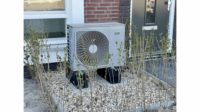A new $4.3 billion federal rebate program is being touted by HVAC manufacturers and environmentalists alike as a big step toward energy savings and reduced carbon emissions.
The High-Efficiency Electric Home Rebate program, or HEEHR, will offer point-of-sale rebates to low- and moderate-income households for the purchase of specific Energy Star-rated electric appliances, including up to $8,000 for a heat pump for home heating and cooling. HEEHR also provides for rebates for the electrical work, such as panel upgrades and new wiring, that some homes may need to accommodate such appliances.
An income-eligible family undertaking a major home electrification project could benefit from an eye-popping maximum of $14,000 in rebates under HEEHR. In addition to rebates for heat pumps and electrical upgrades, the program also offers rebates for new insulation, induction ranges, and heat-pump water heaters and clothes dryers. (HEEHR rebates cannot be combined with other federal rebate programs.)
HEEHR is part of the $737 billion Inflation Reduction Act (IRA), a package of tax, energy, environmental, and health-care legislation signed into law in August. The program is among a number of IRA incentives that aim to promote energy efficiency and electrification and reduce the carbon emissions that contribute to global warming.
Heat pump makers are thrilled with the consumer enticements.
“This is right in the center of our demographic target,” said Mark Kuntz, the CEO of Mitsubishi Electric Trane HVAC U.S., or METUS, which manufactures inverter-compressor heat pumps. “We make the exact kind of equipment the Inflation Reduction Act is focused on.”
“I do think there is great interest,” said Samantha Slater, senior vice president of government affairs at AHRI, which represents manufacturers.
senior vice president of government affairs, AHRI
States to Manage
However, getting HEEHR up and running won’t be as easy as turning down the thermostat or switching off the a/c. The federal money is to be doled out among the states according to an established Department of Energy (DOE) allocation formula, and the disbursement of the rebates will be left to each state’s energy department. (Of the $4.3 billion in rebate money, $225 million is set aside for American Indian tribe programs.)
“It’s going to take a little bit of time to get these programs up and running,” said Slater.
Kuntz is optimistic, saying that he expects some states to have HEEHR rebates in place by the next air-conditioning season. Barton James, president and CEO of the contractors group ACCA, is less so, saying it could take years before details are ironed out.
The HEEHR program runs through September of 2031, but has a two-year deadline for states to establish their programs. States that do not have a DOE-approved HEEHR program within two years risk having the energy department redistribute their allocations to those that do.
According to the IRA, each state must submit to the DOE a blueprint for administering HEEHR rebates that includes a proposed plan for verifying the income eligibility of those seeking rebates.
Income Guidelines
The legislation defines two categories of income eligibility: Households with an income of between 80% and 150% of the area’s median, and those with an income below 80% of the median. Under HEEHR, rebates for the former group are limited to 50% of the cost of an eligible project, while rebates for the latter can cover 100% of the cost.
(So, for example, if two families in the same neighborhood each have a heat pump installed at a cost of $6,000, the family with an income of between 80% and 150% of the median for that area is eligible for a $3,000 rebate, while the family with an income below 80% of the median is eligible for the entire $6,000).
Rebates are also available to the owners of multifamily buildings in which at least 50% of the residents are from low- or moderate-income households, and to companies, nonprofits, and government entities that undertake qualified electrification projects for low- and moderate-income households. In the latter case, the value of the rebate must be passed on to the consumer, but the entity involved is entitled to an incentive bonus of up to $500 per project.
The HEEHR program is for new construction, the replacement of non-electric appliances, and people who are buying eligible products, like heat pumps, for the first time.
Rebates for Retrofits
The IRA also established another $4.3 billion rebate program, this one for retrofits only: the Home Owner Managing Energy Savings, or HOMES. It applies to energy efficiency measures broadly, including to certain HVAC equipment but also to building upgrades like insulation and new windows. HOMES rebates will also be administered by the states, with details also to be set in the coming months.
Under HOMES, a project’s energy savings will have to be documented through a method approved by DOE. Generally, a homeowner who achieves energy savings of between 20% and 35% will be eligible for a rebate of up to $2,000, and a homeowner who achieves energy savings of more than 35% will be eligible for a $4,000 rebate; the program will be slightly different for projects in which energy savings are measured in kilowatt-hours, or kWh equivalents, and the required minimum energy savings for those projects is 15%.
The owners of multifamily buildings will also be eligible for the HOMES program, with the same energy-savings requirements and rebate caps per unit.
HOMES rebates will be available for households of any income level, although low- and moderate-income households could be eligible for enhanced rebates, as could the owners of multi-family buildings in which at least 50% of households have low or moderate incomes.








